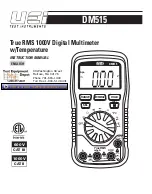
D. AC Current Measurement
(see figure 4 with dotted line)
Warning
Never attempt an in-circuit current measurement
where the voltage between terminals and ground is
greater than 60V or 30V rms
If the fuse burns out during measurement, the Meter
may be damaged or the operator himself may be
hurt. Disconnect power supply before making
measurement. Use proper terminals, function, and
range for the measurement. When the testing leads
are connected to the current terminals, do not parallel
them across any circuit.
To measure current, do the following:
1. Turn off power to the circuit. Discharge all high-voltage
capacitors.
2. Insert the red test lead into the
mA
or
20A
terminal
or
10A
terminal and the black test lead into the
COM
terminal. When measuring current at 200mA below,
insert the red test lead into
mA
terminal while
measuring current 200mA or above, insert the red
test lead into
10A
or
20A
terminal
3. Set the rotary switch to an appropriate measurement
position in
A
range.
4. Break the current path to be tested. Connect the red
test lead to the more positive side of the break and
the black test lead to the more negative side of the
break.
5. Turn on power to the circuit.
The measured value shows on the display.
Note
l
l
l
If the value of current to be measured is unknown, use
the maximum measurement position (20A) and
20A
terminal or (10A) and
10A
terminal, and reduce the
range step by step until a satisfactory reading is
obtained.
Replace appropriate rating fuse when the fuse is burnt.
Fuse specification: 0.315A. 250V fast type fuse,
φ
5 x 20mm
UT39A/UT39B - At 10A Range:
For continuous
measurement 10 seconds and interval not less than
15 minutes.
13
Model UT39A/B/C: OPERATING MANUAL














































